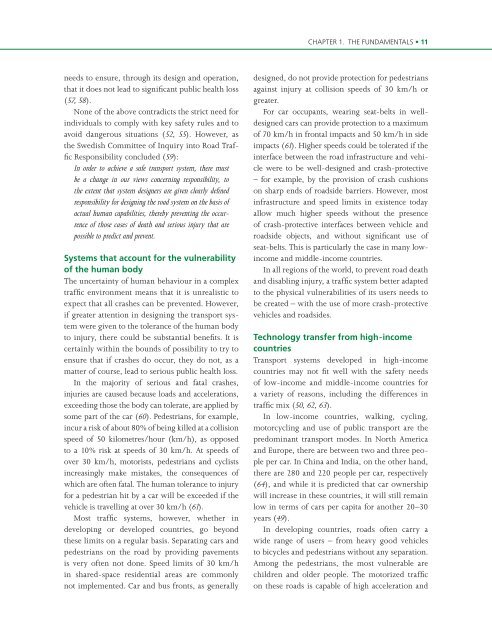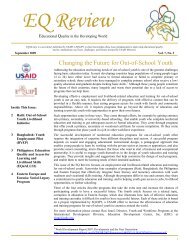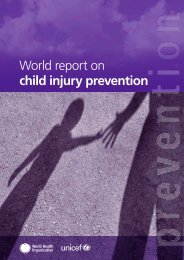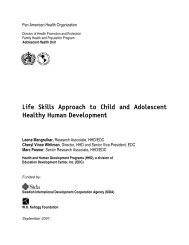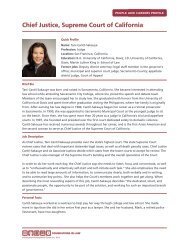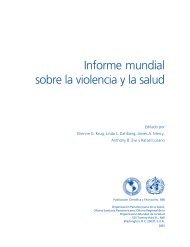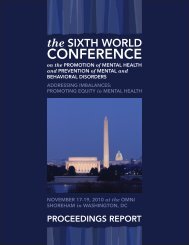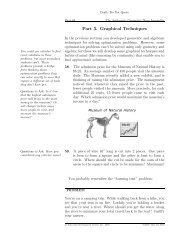World report on road traffic injury prevention edited by M ... - teach-vip
World report on road traffic injury prevention edited by M ... - teach-vip
World report on road traffic injury prevention edited by M ... - teach-vip
You also want an ePaper? Increase the reach of your titles
YUMPU automatically turns print PDFs into web optimized ePapers that Google loves.
CHAPTER 1. THE FUNDAMENTALS • 11<br />
needs to ensure, through its design and operati<strong>on</strong>,<br />
that it does not lead to significant public health loss<br />
(57, 58).<br />
N<strong>on</strong>e of the above c<strong>on</strong>tradicts the strict need for<br />
individuals to comply with key safety rules and to<br />
avoid dangerous situati<strong>on</strong>s (52, 55). However, as<br />
the Swedish Committee of Inquiry into Road Traffic<br />
Resp<strong>on</strong>sibility c<strong>on</strong>cluded (59):<br />
In order to achieve a safe transport system, there must<br />
be a change in our views c<strong>on</strong>cerning resp<strong>on</strong>sibility, to<br />
the extent that system designers are given clearly defi ned<br />
resp<strong>on</strong>sibility for designing the <strong>road</strong> system <strong>on</strong> the basis of<br />
actual human capabilities, there<strong>by</strong> preventing the occurrence<br />
of those cases of death and serious <strong>injury</strong> that are<br />
possible to predict and prevent.<br />
Systems that account for the vulnerability<br />
of the human body<br />
The uncertainty of human behaviour in a complex<br />
<strong>traffic</strong> envir<strong>on</strong>ment means that it is unrealistic to<br />
expect that all crashes can be prevented. However,<br />
if greater attenti<strong>on</strong> in designing the transport system<br />
were given to the tolerance of the human body<br />
to <strong>injury</strong>, there could be substantial benefits. It is<br />
certainly within the bounds of possibility to try to<br />
ensure that if crashes do occur, they do not, as a<br />
matter of course, lead to serious public health loss.<br />
In the majority of serious and fatal crashes,<br />
injuries are caused because loads and accelerati<strong>on</strong>s,<br />
exceeding those the body can tolerate, are applied <strong>by</strong><br />
some part of the car (60). Pedestrians, for example,<br />
incur a risk of about 80% of being killed at a collisi<strong>on</strong><br />
speed of 50 kilometres/hour (km/h), as opposed<br />
to a 10% risk at speeds of 30 km/h. At speeds of<br />
over 30 km/h, motorists, pedestrians and cyclists<br />
increasingly make mistakes, the c<strong>on</strong>sequences of<br />
which are often fatal. The human tolerance to <strong>injury</strong><br />
for a pedestrian hit <strong>by</strong> a car will be exceeded if the<br />
vehicle is travelling at over 30 km/h (61).<br />
Most <strong>traffic</strong> systems, however, whether in<br />
developing or developed countries, go bey<strong>on</strong>d<br />
these limits <strong>on</strong> a regular basis. Separating cars and<br />
pedestrians <strong>on</strong> the <strong>road</strong> <strong>by</strong> providing pavements<br />
is very often not d<strong>on</strong>e. Speed limits of 30 km/h<br />
in shared-space residential areas are comm<strong>on</strong>ly<br />
not implemented. Car and bus fr<strong>on</strong>ts, as generally<br />
designed, do not provide protecti<strong>on</strong> for pedestrians<br />
against <strong>injury</strong> at collisi<strong>on</strong> speeds of 30 km/h or<br />
greater.<br />
For car occupants, wearing seat-belts in welldesigned<br />
cars can provide protecti<strong>on</strong> to a maximum<br />
of 70 km/h in fr<strong>on</strong>tal impacts and 50 km/h in side<br />
impacts (61). Higher speeds could be tolerated if the<br />
interface between the <strong>road</strong> infrastructure and vehicle<br />
were to be well-designed and crash-protective<br />
– for example, <strong>by</strong> the provisi<strong>on</strong> of crash cushi<strong>on</strong>s<br />
<strong>on</strong> sharp ends of <strong>road</strong>side barriers. However, most<br />
infrastructure and speed limits in existence today<br />
allow much higher speeds without the presence<br />
of crash-protective interfaces between vehicle and<br />
<strong>road</strong>side objects, and without significant use of<br />
seat-belts. This is particularly the case in many lowincome<br />
and middle-income countries.<br />
In all regi<strong>on</strong>s of the world, to prevent <strong>road</strong> death<br />
and disabling <strong>injury</strong>, a <strong>traffic</strong> system better adapted<br />
to the physical vulnerabilities of its users needs to<br />
be created – with the use of more crash-protective<br />
vehicles and <strong>road</strong>sides.<br />
Technology transfer from high-income<br />
countries<br />
Transport systems developed in high-income<br />
countries may not fit well with the safety needs<br />
of low-income and middle-income countries for<br />
a variety of reas<strong>on</strong>s, including the differences in<br />
<strong>traffic</strong> mix (50, 62, 63).<br />
In low-income countries, walking, cycling,<br />
motorcycling and use of public transport are the<br />
predominant transport modes. In North America<br />
and Europe, there are between two and three people<br />
per car. In China and India, <strong>on</strong> the other hand,<br />
there are 280 and 220 people per car, respectively<br />
(64), and while it is predicted that car ownership<br />
will increase in these countries, it will still remain<br />
low in terms of cars per capita for another 20–30<br />
years (49).<br />
In developing countries, <strong>road</strong>s often carry a<br />
wide range of users – from heavy good vehicles<br />
to bicycles and pedestrians without any separati<strong>on</strong>.<br />
Am<strong>on</strong>g the pedestrians, the most vulnerable are<br />
children and older people. The motorized <strong>traffic</strong><br />
<strong>on</strong> these <strong>road</strong>s is capable of high accelerati<strong>on</strong> and


